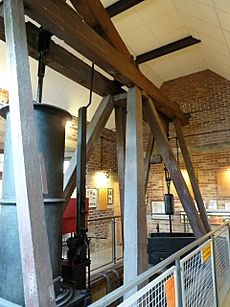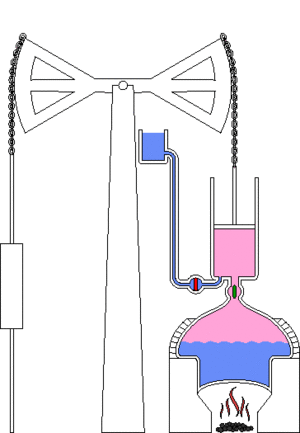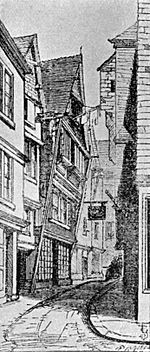Thomas Newcomen facts for kids
Quick facts for kids
Thomas Newcomen
|
|
|---|---|
| Born | 1664 |
| Died | 5 August 1729 (aged 64–65) London, England
|
| Known for | Inventing the first practical Steam engine |
| Scientific career | |
| Influenced | James Watt |
Thomas Newcomen (born February 1664 – died 5 August 1729) was an English inventor. He created the atmospheric engine in 1712. This was the first practical engine that used fuel to work. He was an ironmonger, which means he made and sold tools and metal goods. He was also a Baptist lay preacher.
Newcomen was born in Dartmouth, England. He was baptized on February 28, 1664. Back then, mines often filled with water, which was a big problem. Newcomen worked to find better ways to pump water out of these mines. His business focused on making tools for the mining industry.
Contents
Newcomen's Life and Work
Thomas Newcomen was a religious man. He was a preacher in his local Baptist church. His connections with other Baptists helped his steam engine spread. For example, engineers Jonathan Hornblower Sr. and his son were part of the same church. They helped introduce the engine to new places.
Inventing the Steam Engine
Newcomen's biggest invention was his steam engine, made around 1712. He combined ideas from two other inventors, Thomas Savery and Denis Papin. His goal was to create an engine that could pump water out of tin mines.
Savery had made a "fire engine." It used steam to create a vacuum (an empty space). This vacuum would then suck water up from the bottom of a mine. But Savery's engine could only lift water about 30 feet.
Newcomen improved this idea. He added a cylinder with a piston, based on Papin's design. Instead of the vacuum sucking water directly, it pulled down the piston. This piston was connected to a large wooden beam. The beam rocked back and forth like a seesaw. On the other side of the beam, a chain was attached to a pump deep in the mine.
When steam filled the cylinder, the piston moved up. Then, cold water was sprayed into the cylinder. This made the steam turn back into water, creating a vacuum. The vacuum pulled the piston down, which pulled down one side of the beam. The other side of the beam went up, pulling the pump and lifting water out of the mine.
Newcomen and his partner John Calley built the first successful engine of this kind. It was near Dudley in the West Midlands. You can see a working copy of this engine at the Black Country Living Museum today.
Later Years and Impact
Not much is known about Newcomen's later life. He died in 1729 and was buried in London.
By 1733, about 125 Newcomen engines were working. They were used in mines all over Britain and Europe. They helped drain water from coal, tin, copper, and lead mines.
The Engine's Legacy
The Newcomen engine was used for about 75 years without many changes. At first, the cylinders were made of brass, which was expensive. But new ways of casting iron in the 1720s allowed for bigger, cheaper cylinders.
John Smeaton made many improvements to the engine in the 1770s. His changes made the engines work better. By 1775, about 600 Newcomen engines had been built.
Improvements and New Engines
The Newcomen engine was not very efficient. It lost a lot of heat when the steam cooled down. This was okay in coal mines, where cheap coal was easy to find. But in places like Cornwall, where coal was expensive, it was a problem.
After 1775, a new design by James Watt began to replace Newcomen's engine. Watt's engine condensed the steam in a separate part, which saved a lot of fuel. This made Watt's engine much more efficient.
Watt also made other improvements, like the double-acting engine. This meant the engine had power on both the up and down strokes. These were great for driving machines in textile factories.
Even with Watt's improvements, Newcomen-style engines were still built. They were cheaper and simpler. Many Newcomen engines were also updated with parts of Watt's design, like the separate condenser.
Where to See Newcomen Engines Today

You can see examples of Newcomen engines in museums. There's one at the Science Museum, London in England and another at the Ford Museum in the US.
In 1964, a Newcomen engine from Warwickshire was moved to Dartmouth. You can see it working there, but it uses a hydraulic system instead of steam. This engine is thought to be from around 1725.
Perhaps the last Newcomen-style engine still in its original place is at the Elsecar Heritage Centre in South Yorkshire. It was fixed up and started working again in 2016. Another working copy is at the Black Country Living Museum in Dudley.
Recognition
On February 23, 2012, the Royal Mail released a stamp. It featured Newcomen's atmospheric steam engine. This was part of their "Britons of Distinction" series.
See also
In Spanish: Thomas Newcomen para niños



